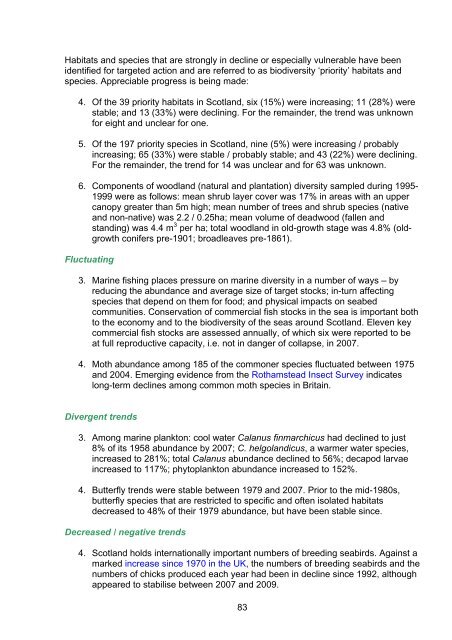Scotland's Wildlife â an assessment of biodiversity in 20
Scotland's Wildlife â an assessment of biodiversity in 20
Scotland's Wildlife â an assessment of biodiversity in 20
Create successful ePaper yourself
Turn your PDF publications into a flip-book with our unique Google optimized e-Paper software.
Habitats <strong>an</strong>d species that are strongly <strong>in</strong> decl<strong>in</strong>e or especially vulnerable have been<br />
identified for targeted action <strong>an</strong>d are referred to as <strong>biodiversity</strong> ‘priority’ habitats <strong>an</strong>d<br />
species. Appreciable progress is be<strong>in</strong>g made:<br />
4. Of the 39 priority habitats <strong>in</strong> Scotl<strong>an</strong>d, six (15%) were <strong>in</strong>creas<strong>in</strong>g; 11 (28%) were<br />
stable; <strong>an</strong>d 13 (33%) were decl<strong>in</strong><strong>in</strong>g. For the rema<strong>in</strong>der, the trend was unknown<br />
for eight <strong>an</strong>d unclear for one.<br />
5. Of the 197 priority species <strong>in</strong> Scotl<strong>an</strong>d, n<strong>in</strong>e (5%) were <strong>in</strong>creas<strong>in</strong>g / probably<br />
<strong>in</strong>creas<strong>in</strong>g; 65 (33%) were stable / probably stable; <strong>an</strong>d 43 (22%) were decl<strong>in</strong><strong>in</strong>g.<br />
For the rema<strong>in</strong>der, the trend for 14 was unclear <strong>an</strong>d for 63 was unknown.<br />
6. Components <strong>of</strong> woodl<strong>an</strong>d (natural <strong>an</strong>d pl<strong>an</strong>tation) diversity sampled dur<strong>in</strong>g 1995-<br />
1999 were as follows: me<strong>an</strong> shrub layer cover was 17% <strong>in</strong> areas with <strong>an</strong> upper<br />
c<strong>an</strong>opy greater th<strong>an</strong> 5m high; me<strong>an</strong> number <strong>of</strong> trees <strong>an</strong>d shrub species (native<br />
<strong>an</strong>d non-native) was 2.2 / 0.25ha; me<strong>an</strong> volume <strong>of</strong> deadwood (fallen <strong>an</strong>d<br />
st<strong>an</strong>d<strong>in</strong>g) was 4.4 m 3 per ha; total woodl<strong>an</strong>d <strong>in</strong> old-growth stage was 4.8% (oldgrowth<br />
conifers pre-1901; broadleaves pre-1861).<br />
Fluctuat<strong>in</strong>g<br />
3. Mar<strong>in</strong>e fish<strong>in</strong>g places pressure on mar<strong>in</strong>e diversity <strong>in</strong> a number <strong>of</strong> ways – by<br />
reduc<strong>in</strong>g the abund<strong>an</strong>ce <strong>an</strong>d average size <strong>of</strong> target stocks; <strong>in</strong>-turn affect<strong>in</strong>g<br />
species that depend on them for food; <strong>an</strong>d physical impacts on seabed<br />
communities. Conservation <strong>of</strong> commercial fish stocks <strong>in</strong> the sea is import<strong>an</strong>t both<br />
to the economy <strong>an</strong>d to the <strong>biodiversity</strong> <strong>of</strong> the seas around Scotl<strong>an</strong>d. Eleven key<br />
commercial fish stocks are assessed <strong>an</strong>nually, <strong>of</strong> which six were reported to be<br />
at full reproductive capacity, i.e. not <strong>in</strong> d<strong>an</strong>ger <strong>of</strong> collapse, <strong>in</strong> <strong>20</strong>07.<br />
4. Moth abund<strong>an</strong>ce among 185 <strong>of</strong> the commoner species fluctuated between 1975<br />
<strong>an</strong>d <strong>20</strong>04. Emerg<strong>in</strong>g evidence from the Rothamstead Insect Survey <strong>in</strong>dicates<br />
long-term decl<strong>in</strong>es among common moth species <strong>in</strong> Brita<strong>in</strong>.<br />
Divergent trends<br />
3. Among mar<strong>in</strong>e pl<strong>an</strong>kton: cool water Cal<strong>an</strong>us f<strong>in</strong>marchicus had decl<strong>in</strong>ed to just<br />
8% <strong>of</strong> its 1958 abund<strong>an</strong>ce by <strong>20</strong>07; C. helgol<strong>an</strong>dicus, a warmer water species,<br />
<strong>in</strong>creased to 281%; total Cal<strong>an</strong>us abund<strong>an</strong>ce decl<strong>in</strong>ed to 56%; decapod larvae<br />
<strong>in</strong>creased to 117%; phytopl<strong>an</strong>kton abund<strong>an</strong>ce <strong>in</strong>creased to 152%.<br />
4. Butterfly trends were stable between 1979 <strong>an</strong>d <strong>20</strong>07. Prior to the mid-1980s,<br />
butterfly species that are restricted to specific <strong>an</strong>d <strong>of</strong>ten isolated habitats<br />
decreased to 48% <strong>of</strong> their 1979 abund<strong>an</strong>ce, but have been stable s<strong>in</strong>ce.<br />
Decreased / negative trends<br />
4. Scotl<strong>an</strong>d holds <strong>in</strong>ternationally import<strong>an</strong>t numbers <strong>of</strong> breed<strong>in</strong>g seabirds. Aga<strong>in</strong>st a<br />
marked <strong>in</strong>crease s<strong>in</strong>ce 1970 <strong>in</strong> the UK, the numbers <strong>of</strong> breed<strong>in</strong>g seabirds <strong>an</strong>d the<br />
numbers <strong>of</strong> chicks produced each year had been <strong>in</strong> decl<strong>in</strong>e s<strong>in</strong>ce 1992, although<br />
appeared to stabilise between <strong>20</strong>07 <strong>an</strong>d <strong>20</strong>09.<br />
83
















